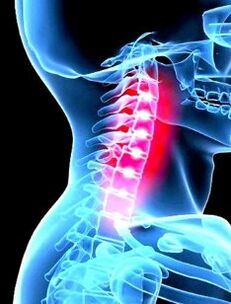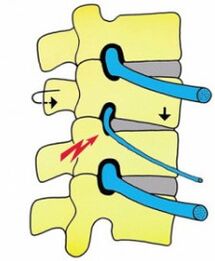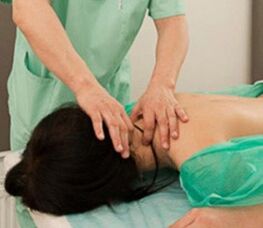Cervical osteocondrosis is a disease that is a dystrophic and degenerative disorders of the cervical discs in the spine. The cervical department is the most mobile, the muscle corset in this department in relation to others is much weaker. The neck performs the rotation and inclination of the head, so that the spine in this area is subject to deformations, destruction, hernia and curvature formations.

The main causes of the disease
It has been found that osteocondrosis is a disease that "becomes young". Now this disease is increasingly found among people aged 18 to 30, while earlier cases of 40 were considered the norm. The reasons for this can be distinguished by the following:
- violation of posture, the presence of spinal cord basket according to the type of scoliosis, lordosis or kyphosis;
- overweight, obesity;
- back injuries;
- Metabolic disorder, low metabolism;
- Hard physical work;
- Hypodynamia, sedentary lifestyle;
- weak physical exercise;
- Nervous exhaustion, stress;
- Failure to comply with hygiene education in athletes;
- Sharp ending of training;
- infectious diseases;
- Hypothermia in the body.
Osteochondrosis is essentially a consequence of muscle clamps, muscle spasm ultimately fetter's mobility of the cervical spine, disturbs blood circulation, aggravates the blood supply to bones and muscle tissue, provoking the development of dystrophic processes in disks and vertebrae, narrowing of intervertebral interving. As a result - pressed nerve roots and loss of sensitivity.
Cervical osteochondrosis symptoms
Cervical osteochondrosis has a number of symptoms. However, manifestation mostly affects the manifestation of osteochondrosis. In the cervical region there are many blood vessels that intensively nourish the brain. Therefore, the danger of osteocondrosis is associated with a poor supply of the organs of the head, especially the brain, blood. What signs of osteocondrosis in cervical spine will be expressed affected by the segment defeated. Therefore, the following signs of cervical osteocondrosis are separated:
- Roots Syndromes;
- Cardinal Syndrome;
- Annoying reflex syndromes;
- vertebral arteris syndrome;
- Compression of the spinal cord.

What are the symptoms of cervical osteocondrosis in case of rooser syndrome is characteristic? Rooses -syndrome in medicine is called cervical radiculitis, it occurs due to the squeezing of the nerve in the neck. Pain occurs in the neck, go down into the zone of the shoulder blades, may be lower on the shoulder and forearm, up to the fingers. The characteristic signs of cervical osteocondrosis in this case are the experience of tingling, burning senses, pastoicity, numbness in the hands, forearm or fingers.
Symptoms of osteochondrosis in the cervical region will have different, which segment decreased during damage to the disease will affect their difference. In the event that the central nerve and its roots are affected, the pastone will be middle, index as well as the thumb. If the roots of the shoulder nerve were affected, the pastone will be a small finger and a ring finger. Osteocondrosis in cervical spine, the symptoms will have the following syndrome as an irritant reflex. The main function will be the presence of acute, intense, burning pain in the cervical-and-intensive region or at the neck itself. The pain tends to rise during movement or loads, it is especially acute after a static condition. For example, after sleep, with inaccurate turns upside down, after sleep. The cervical osteocondrosis of the symptoms has similar, because with the development of this syndrome, the pain is transmitted to the breast. It is diagnosed in cases where the injury zone is not limited to the neck but goes to the segments in the chest. Symptoms show a larger spectrum of cervical osteocondrosis, the most head of them is a violation of the work of internal organs.
Spinal arteries syndrome - the worsening of cervical osteocondrosis, the symptoms appear extremely intense and consist of severe, burning pain. The pulsating pain in the temples, the presence of severe migraines, especially astonishing the parietal part, the back of the head and the front -region is characteristic. The pain is chronic, constant, but sometimes they detect cases of paroxysmal pain. Aggravation of osteocondrosis of cervical spine expresses symptoms in the form of rising pain. This happens after being in unpleasant positions with sudden movements, severe physical exertion. Aggravation threatens with auditory disorders - a vestibular disorder that experiences noise in the ears, as well as a decrease in flax sharpness. Vision problems are not uncommon. Osteochondrosis of cervical spy symptoms with cardinal syndrome. The cardinal syndrome is characterized by severe angina pectoris. This makes it difficult to identify the primary disease - osteochondrosis. Diagnosis "Osteochondrosis in the cervical region" is often performed in a timely way as they try to diagnose angina pectoris and treat it, this threatens the transition of osteochondrosis to a chronic form.

The phenomenon of angina pectoris is provided by squeezing the spine in the lower segments of the cervical region that finds a reflex response. Cardinal syndrome can manifest itself in cases where the roots of the chest or membrane nerve are irritated. Osteocondrosis of cervical spine -symptoms with cardinal syndrome can be manifested in the form of tachycardia, extrasystol. There are frequent cases where osteocondrosis in the cervical region and hypertension also continues jointly. Similarly, symptoms of cervical osteocondrosis are symptoms, its treatment does not always come out in a timely manner, as doctors initially diagnose heart -vessel diseases and not osteocondrosis.
Cervical osteochondrosis symptoms and treatment
A particular syndrome is diagnosed based on the consideration of certain symptoms, treatment is already performed on the basis of this. Treatment is performed in two ways: either radical, which involves surgical intervention or a conservative method. In these cases, if conservative treatment did not produce results, an indication of surgery is prescribed. Osteocondrosis in the cervical region is removed by the following methods:
- Manual therapy;
- Massage treatments, physiotherapeutic procedures;
- Reflexotherapy - Acupuncture;
- medical treatment, pills;
- water procedures;
- Folk methods for treatment;
- LFK courses as well as wellness gymnastics.
Cervical osteocondrosis symptoms treatment of tablet
Typically, drug treatment is prescribed in cases where the symptoms include the presence of severe pain. In fact, pills are not a universal agent from the cause of pain - osteochondrosis itself. The tablets are also prescribed if the temperature of osteochondrosis of cervical spine has increased. This symptom indicates the presence of inflammatory processes in the body, inflammation of the tissues and nerves must be removed.

Cervical osteocondrosis, symptoms, treatment and gymnastics
An effective and affordable treatment method is considered a complex of exercise therapy and gymnastics exercises. Exercises are aimed at increasing the flexibility of the cervix spine, increasing medium discuses, strengthening the muscle corset that would protect the spine from injuries and injuries. Gymnastics and exercises also very effectively establish the function of the circulation system, this not only promotes bone tissue, but also allows us to normalize blood flow to the brain. The most important thing is to perform exercises under the supervision of a doctor.
Cervical osteocondrosis, symptoms and surgical treatment
In the event that conservative treatment did not produce results, the operation is prescribed. It allows for the removal of processes, arches and ligaments as well as the removal of hernias that fell into the spine. Following this procedure, cases of the total instability in the cervical region are not uncommon. After surgery, a special supporting collar is prescribed for the patient that stabilizes a slight neck and supports it temporarily.
As a rule, if you diagnose the disease in a timely manner, keep the strict recommendations from the doctor and participate in extensive conservative therapy, then osteochondrosis is significantly adjusted, in many cases a picture of complete improvement is observed.



























